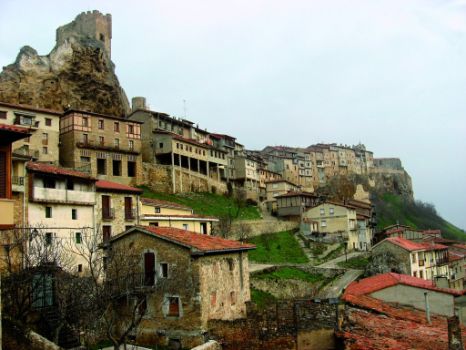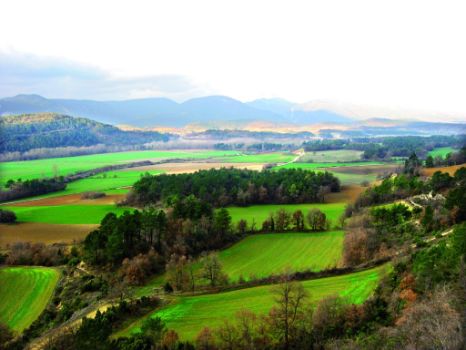Net of Natural
Trails

Stage 9: Trespaderne - Quintana Martín Galíndez
Description
In Trespaderne (535 m), along the River Nela, the route starts near the recreation area, following the track on the left bank that leads to the bridge over the Ebro. After crossing the bridge, the route continues straight ahead along a path between fields. To the right lies the place where the Nela joins the Ebro, an island increasingly populated by ashes.
The road to Castrillo gradually drifts away from the river, skirting around the namesake hill (584 m). The route not only runs through a reforestation pine forest, but also between gall oak and deciduous woodlands that populate the surrounding mountains. Cillaperlata is accessed by a paved road near the bridge and dam whence the Canal Central de Quintana starts (5 km, 1h 15min).

The town is located under a rocky crag in a backwater of the Ebro. It is home to the parish church of Nuestra Señora de Covadonga with an ancient wooden statue of the Virgin Mary, copy of a 12th century Asturian image. There are also several manors and two hermit caves.
A track heads southeast from the stone basin (where it links with the trail end of Section 9.1). The GR 99 continues straight ahead along a valley, past Cantarillos Brook and Peña de la Dehesa (646 m), towards Cucharera Hill (600 m). It then descends to Quintanaseca, home to the Romanesque church of San Martín and several emblazoned manors.
The route heads down the road leading to BU-520, then climbs up to Frías, and continues straight ahead to the car park (12.2 km, 2hr 50min), whence it is possible to visit the medieval bridge and the town, whose history can be traced back to the ninth century.
On the left side of the bridge is a path parallel to the Ebro. Through a riparian forest of black poplars, holm oaks and an occasional boxwood, the route climbs to a belt of meadows and disregards a track to the left. It continues to a country house, from where the track heads along the upper field and woodland next to the river towards a marked path, which follows the course of the Ebro, bounded by the rocky slopes of Mount San Miguel, crowned with the namesake Romanesque shrine.

The track winds through a gorge; a woodland populated with species identified with plaques - Lombardy poplar, black poplar, ash, etc. - through which a botanical route traverses. The track comes upon a path that runs under the Montejo de Cebas Weir, built in the late nineteenth century.
The route turns left and begins to climb towards Montejo de San Miguel (16.4 km, 4hr), with traditional houses scattered across a lush landscape. A place ideally suited for walks along various existing routes. Here, the Section leaves behind Montes Obarenes-San Zadornil Nature Park.
The route continues along Mayor Street to a rest area and the stairs leading down to the Montejo de Cebas road. It heads straight ahead and then turns onto a riverside track to the right through fields, past the river island and Vega de San Sebastián natural reserve, to cross San Antonio Brook and reach the road to Quintana.
After 500 m, an offshoot road to the right leads to the bridge over Iberduero's central canal, which gives access to Quintana, the capital, administrative and service centre of Tobalina Valley (545 m; 20.7 km; 4hr 55min). The origin of the town, home to the Gothic church of Santo Tomás Apóstol (16th-18th C.), the medieval tower of Salazar (11th C.) and the shrine of San Roque, has been traced back to the 11 century.
Sites of interest
Puntos de interés
Culture
Hydrography
Infrastructure
Municipality
Hostel
Profile

Highlights
Further information
The Art of Frías
The neighbourhoods of La Muela, San Vitores, San Pedro and San Francisco enclose an array of row houses perched on a rock outcrop, which form steep, staggered streets or hang over the sentry walks on the ramparts. Frías was awarded the first prize in the 1976 Provincial Beautification Contest, owing to its typical solarium-galleries and the use of tuff and wood in its buildings. It also home to the Castle of Velasco (12th C.), the church of San Vicente; the Wall of La Muela (13th C.), a medieval bridge (14th C.); the convent of San Francisco (14th C.), the church of San Vitores (12th-14th C.), and the convent of Santa María de Vadillo and its flour mills.




